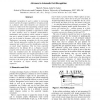Free Online Productivity Tools
i2Speak
i2Symbol
i2OCR
iTex2Img
iWeb2Print
iWeb2Shot
i2Type
iPdf2Split
iPdf2Merge
i2Bopomofo
i2Arabic
i2Style
i2Image
i2PDF
iLatex2Rtf
Sci2ools
FGR
2004
IEEE
2004
IEEE
Advances in Automatic Gait Recognition
Automatic recognition by gait is subject to increasing interest and has the unique capability to recognize people at a distance when other biometrics are obscured. Its interest is reinforced by the longstanding computer vision interest in automated non-invasive analysis of human motion. Its recognition capability is supported by studies in other domains such as medicine (biomechanics), mathematics and psychology which continue to suggest that gait is unique. Further, examples of recognition by gait can be found in literature, with early reference by Shakespeare concerning recognition by the way people walk. Current approaches confirm the early results that suggested gait could be used for identification, and now on much larger databases. This has been especially influenced by the Human ID at a Distance research program with its wide scenario of data and approaches. Gait has benefited from the developments in other biometrics and has led to new insight particularly in view of covariate...
| Added | 20 Aug 2010 |
| Updated | 20 Aug 2010 |
| Type | Conference |
| Year | 2004 |
| Where | FGR |
| Authors | Mark S. Nixon, John N. Carter |
Comments (0)

